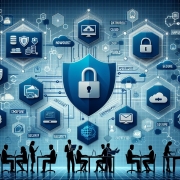

Check Point Harmony Endpoint and VMware Carbon Black Cloud are prominent competitors in the endpoint security market. Check Point Harmony Endpoint stands out due to its user-friendly interface and ease of deployment, while VMware Carbon Black Cloud is noted for its real-time protection.
Features: Check Point Harmony Endpoint offers anti-ransomware, zero-day protection, and integration with other security tools. VMware Carbon Black Cloud provides threat hunting, real-time protection, and a lightweight design that minimizes user impact.
Room for Improvement: Check Point Harmony Endpoint could enhance pricing, deployment complexity, and support response times. Improvements in user interface intuitiveness and third-party integration are also suggested. For VMware Carbon Black Cloud, addressing its high cost and integration complexities would be beneficial.
Ease of Deployment and Customer Service: Check Point Harmony Endpoint supports flexible deployment, including on-premises and cloud configurations. Its customer service, while generally responsive, faces criticism for complex inquiries. VMware Carbon Black Cloud provides seamless integration with hybrid cloud support but is more complex in setup and management. It struggles with service quality in international regions.
Pricing and ROI: Check Point Harmony Endpoint offers flexible licensing options, aligning well with organizations seeking cost-effective solutions and promising significant returns by reducing cybersecurity incidents. VMware Carbon Black Cloud, though more expensive, offers robust security benefits. Both solutions yield satisfactory ROI, but Check Point is more appealing to cost-sensitive buyers.
Initially, we spent two to three days on the investigation process, but now we are able to investigate alerts in only half a day, which has really boosted our performance and shown a return on investment.
The product is affordable and provides excellent coverage and protection across multiple platforms.
I have seen a return on investment with Check Point Harmony Endpoint, as it has saved money and time due to the minimum disruption of production hours, which allows users to focus on their main tasks and desired targets, avoiding downtime and contributing to business growth.
It's crucial to assess the support capability before acquiring the Check Point device or consider alternatives.
The customer support for Check Point Harmony Endpoint deserves a rating of 10.
We use premium support, and it is beneficial as 24/7 support is available.
We initially purchased only 100 licenses and as we grew, we acquired many more licenses without encountering any issues.
Proactive features help guard against data breaches and vulnerabilities.
Allowing us to add more users or endpoints for protection as our organization grows without any issues.
I have seen a return on investment with Check Point Antivirus, and indeed it has saved time and reduced the need for additional employees.
The stability of the tool is high, as I have not experienced any downtime.
Check Point Harmony Endpoint is stable for our organization size of 1,000 to 10,000 members.
Better technical support would enhance the product's competitiveness.
High resource consumption, requiring high-performance PCs on our endpoint site.
The Endpoint Agent can be more lightweight so that older machines and laptops can easily handle its consumption.
It is not expensive and provides comprehensive coverage.
Pricing is a bit expensive but justified by the product’s features, capabilities, and scalability.
My experience with pricing, setup costs, and licensing reveals that while it is a bit higher than previous SMB devices, the pricing is worth it for what we are getting in terms of protection and features.
Check Point Harmony Endpoint protects our company by warning us against clicking any malicious links and prevents our hosts from becoming vulnerable to cyber attacks.
The anti-ransomware and threat emulation features have significantly helped our organization as they prevent attackers from encrypting files during ransomware attacks, allowing the system to re-decrypt files and restore them to their original forms, effectively stopping ransomware attacks.
Check Point Harmony Endpoint offers top tier security, AI-powered threat prevention, and strong scalability, which stand out as the best features.


Check Point Harmony Endpoint provides advanced threat prevention with centralized management and seamless integration, safeguarding networks through robust security features and real-time threat detection. It excels at ransomware prevention, encryption protection, and detailed threat analysis.
Check Point Harmony Endpoint is renowned for its comprehensive security features, including anti-ransomware capabilities and centralized management. It integrates seamlessly with existing systems, enhancing network protection through features like SandBlast Agent and threat emulation. Organizations benefit from significant incident reductions, utilizing its powerful threat detection, forensics, VPN capabilities, and robust encryption measures. Centralized management during remote work setups and enhanced security through URL filtering and rollback mechanisms further solidify its efficiency. Despite its high resource consumption and configuration challenges, it remains a preferred choice among enterprises aiming to enhance cybersecurity measures.
What Key Features Does Check Point Harmony Endpoint Offer?In sectors such as finance and healthcare, Check Point Harmony Endpoint is crucial for maintaining data security and regulatory compliance. Its features cater to endpoint protection requirements across industries, providing reliable solutions for encryption and cybersecurity challenges. The tool's deployment across diverse environments secures endpoint systems effectively, ensuring uninterrupted operations amid evolving threats.
We monitor all Endpoint Detection and Response (EDR) reviews to prevent fraudulent reviews and keep review quality high. We do not post reviews by company employees or direct competitors. We validate each review for authenticity via cross-reference with LinkedIn, and personal follow-up with the reviewer when necessary.